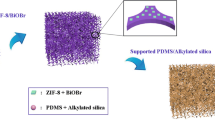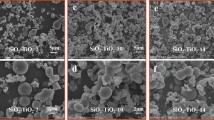Abstract
It is a challenge to endow the material with the ability to pollutants degradation while maintaining the oil/water separation performance. Herein, the mixed dispersion of BiOBr photocatalyst and silicone sol was adsorbed in melamine foam. Superhydrophobic BiOBr-silicone aerogel (WCA=154°) was obtained through the transfer melamine foam to an autoclave and reaction at 80°C for 20 h. The prepared superhydrophobic BiOBr-silicone aerogel can effectively remove the water soluble pollutants which remain within the water phase after oil/water separation. The band gap of the superhydrophobic BiOBr-silicone aerogel was calculated to be 2.71 eV, which shows sensitivity to visible light (458 nm). Through mechanism analysis, it is found that the VB position of BiOBr is at 1.07 eV and the position of CB is at -1.64 eV. Finally, we prepared a superhydrophobic BiOBr-silicone aerogel (5 cm×5 cm×3 cm) for the verification of the large scale preparation.
Similar content being viewed by others
References
Eom S, Kang D W, Kang M, et al. Fine-tuning of wettability in a single metal-organic framework via postcoordination modification and its reduced graphene oxide aerogel for oil-water separation. Chem Sci, 2019, 10: 2663–2669
Ge B, Ren G N, Zhao P F, et al. Preparation of superhydrophobic CdS cotton using visible light response and its application for the control of water pollution. Sci China Tech Sci, 2019, 62: 2236–2242
Ma W, Zhang M, Liu Z, et al. Nature-inspired creation of a robust free-standing electrospun nanofibrous membrane for efficient oil-water separation. Environ Sci-Nano, 2018, 5: 2909–2920
Wang F, Lei S, Ou J, et al. Novel all-natural material for oil/water separation. Ind Eng Chem Res, 2019, 58: 1924–1931
Lin B, Chen J, Li Z T, et al. Superhydrophobic modification of polyurethane sponge for the oil-water separation. Surf Coatings Tech, 2019, 359: 216–226
Tenjimbayashi M, Samitsu S, Naito M. Wetting defects: Simultaneous detection and repair of wetting defects in superhydrophobic coatings via Cassie-Wenzel transitions of liquid marbles (Adv. Funct. Mater. 26/2019). Adv Funct Mater, 2019, 29: 1970180
Avossa J, Bifulco A, Amendola E, et al. Forming nanostructured surfaces through Janus colloidal silica particles with nanowrinkles: A new strategy to superhydrophobicity. Appl Surf Sci, 2019, 465: 73–81
Ge B, Li F, Zhao X, et al. Superhydrophobic CdS-melamine elastomer catalyst design with evaluation of its pollutant degradation performance under visible light. Appl Phys A, 2019, 125: 795–801
Cao N, Guo J Y, Boukherroub R, et al. Robust superhydrophobic polyurethane sponge functionalized with perfluorinated graphene oxide for efficient immiscible oil/water mixture, stable emulsion separation and crude oil dehydration. Sci China Tech Sci, 2019, 62: 1585–1595
Hu T, Li L, Zhang J. Green synthesis of ant nest-inspired superelastic silicone aerogels. ACS Sustain Chem Eng, 2018, 6: 11222–11227
Li L, Hu T, Yang Y, et al. Strong, compressible, bendable and stretchable silicone sponges by solvent-controlled hydrolysis and polycondensation of silanes. J Colloid Interface Sci, 2019, 540: 554–562
Zhang X, Zhu W, Parkin I P. A free-standing porous silicon-type gel sponge with superhydrophobicity and oleophobicity. RSC Adv, 2017, 7: 31–36
Mu L, Yang S, Hao B, et al. Ternary silicone sponge with enhanced mechanical properties for oil-water separation. Polym Chem, 2015, 6: 5869–5875
Li Y, Zhu X, Ge B, et al. Versatile fabrication of magnetic carbon fiber aerogel applied for bidirectional oil-water separation. Appl Phys A, 2015, 120: 949–957
Li Y, Zhang Z, Wang M, et al. One-pot fabrication of nanoporous polymer decorated materials: From oil-collecting devices to high-efficiency emulsion separation. J Mater Chem A, 2017, 5: 5077–5087
Shami Z, Delbina S, Amininasab S M. Wool-like fibrous nonwoven mesh with ethanol-triggered transition between antiwater and antioil superwetting states for immiscible and emulsified light oil-water separation. Langmuir, 2019, 35: 10491–10504
Dong X, Gao S, Huang J, et al. A self-roughened and biodegradable superhydrophobic coating with UV shielding, solar-induced selfhealing and versatile oil-water separation ability. J Mater Chem A, 2019, 7: 2122–2128
Zhang G, Yuan S, Cao S, et al. Functionalized poly(arylene ether sulfone) containing hydroxyl units for the fabrication of durable, superhydrophobic oil/water separation membranes. Nanoscale, 2019, 11: 7166–7175
Fan T, Miao J, Li Z, et al. Bio-inspired robust superhydrophobicsuperoleophilic polyphenylene sulfide membrane for efficient oil/water separation under highly acidic or alkaline conditions. J Hazard Mater, 2019, 373: 11–22
Wang Y, Lai H, Cheng Z, et al. Gecko toe pads inspired in situ switchable superhydrophobic shape memory adhesive film. Nanoscale, 2019, 11: 8984–8993
Deng L, Li P, Liu K, et al. Robust superhydrophobic dual layer nanofibrous composite membranes with a hierarchically structured amorphous polypropylene skin for membrane distillation. J Mater Chem A, 2019, 7: 11282–11297
Miao X, Han L, Wang L, et al. Preparation of PDVB/TiO2 composites and the study on the oil-water separation and degradation performances. Sci China Tech Sci, 2019, 62: 1217–1223
Li Y, Zhang Z, Ge B, et al. One-pot, template-free synthesis of a robust superhydrophobic polymer monolith with an adjustable hierarchical porous structure. Green Chem, 2016, 18: 5266–5272
Yang J, Xia Y, Xu P, et al. Super-elastic and highly hydrophobic/superoleophilic sodium alginate/cellulose aerogel for oil/water separation. Cellulose, 2018, 25: 3533–3544
Shin J H, Heo J H, Jeon S, et al. Bio-inspired hollow PDMS sponge for enhanced oil-water separation. J Hazard Mater, 2019, 365: 494–501
Tang Y, Zhang X, Ma Y, et al. One-dimensional core-shell Zn0.1Cd0.9S/Snln4S8 heterojunction for enhanced visible light photocatalytic degradation. Separation Purification Tech, 2020, 230: 115896
Zhang Z J, Huang H R, Xu J Y, et al. Carbon quantum dots/BiVO4 composite with enhanced photocatalytic activity. Sci China Tech Sci, 2019, 62: 356–360
Tang Y, Kong D, Wang X, et al. Construction of direct Z-scheme system for enhanced visible light photocatalytic activity based on Zn0.1Cd0.9S/FeWO4 heterojunction. Nanotechnology, 2019, 30: 475704
Tang Y, Zhang D, Li Y, et al. Fabrication of magnetically recoverable Ag/CuNb2O6/CuFe2O4 ternary heterojunction composite for highly efficient photocatalytic degradation of pollutants. Separation Purification Tech, 2019, 220: 78–88
Yang J, Chen Y, Xu P, et al. Fabrication of compressible and underwater superoleophobic carbon/g-C3N4 aerogel for wastewater purification. Mater Lett, 2019, 254: 210–213
Zhang S, Li J, Wang X, et al. In situ ion exchange synthesis of strongly coupled Ag@AgCl/g-C3N4 porous nanosheets as plasmonic photocatalyst for highly efficient visible-light photocatalysis. ACS Appl Mater Interfaces, 2014, 6: 22116–22125
Cao F, Wang J, Wang Y, et al. An in situ Bi-decorated BiOBr photocatalyst for synchronously treating multiple antibiotics in water. Nanoscale Adv, 2019, 1: 1124–1129
Bing X, Jian X, Chu J, et al. Hierarchically porous BiOBr/ZnAl1.8Fe0.2O4 and its excellent adsorption and photocatalysis activity. Mater Res Bull, 2019, 110: 1–12
Deng W, Pan F, Batchelor B, et al. Mesoporous TiO2-BiOBr microspheres with tailorable adsorption capacities for photodegradation of organic water pollutants: probing adsorption-photocatalysis synergy by combining experiments and kinetic modeling. Environ Sci-Water Res Technol, 2019, 5: 769–781
Xu J, Mao Y G, Liu T, et al. Synthesis of a novel one-dimensional BiOBr-Bi4O5Br2 heterostructure with a high quality interface and its enhanced visible-light photocatalytic activity. CrystEngComm, 2018, 20: 2292–2298
Wang H, Yong D, Chen S, et al. Oxygen-vacancy-mediated exciton dissociation in BiOBr for boosting charge-carrier-involved molecular oxygen activation. J Am Chem Soc, 2018, 140: 1760–1766
Wei X X, Cui B, Wang X, et al. Tuning the physico-chemical properties of BiOBr via solvent adjustment: Towards an efficient photocatalyst for water treatment. CrystEngComm, 2019, 21: 1750–1757
Porcar R, Nuevo D, García-Verdugo E, et al. New porous monolithic membranes based on supported ionic liquid-like phases for oil/water separation and homogenous catalyst immobilisation. Chem Commun, 2018, 54: 2385–2388
Kim J G, Cha M C, Lee J, et al. Preparation of a sulfur-functionalized microporous polymer sponge and in situ growth of silver nanoparticles: A compressible monolithic catalyst. ACS Appl Mater Interfaces, 2017, 9: 38081–38088
Zhou S, Chen G, Feng X, et al. In situ MnOx/N-doped carbon aerogels from cellulose as monolithic and highly efficient catalysts for the upgrading of bioderived aldehydes. Green Chem, 2018, 20: 3593–3603
Chen S Y, Tang W, He J, et al. Copper manganese oxide enhanced nanoarray-based monolithic catalysts for hydrocarbon oxidation. J Mater Chem A, 2018, 6: 19047–19057
Ma Y, Ma Y, Zhao Z, et al. Comparison of fibrous catalysts and monolithic catalysts for catalytic methane partial oxidation. Renew Energy, 2019, 138: 1010–1017
Singh J, Sharma S, Aanchal S, et al. Synthesis of Fe2O3/TiO2 monoliths for the enhanced degradation of industrial dye and pesticide via photo-Fenton catalysis. J PhotoChem PhotoBiol A-Chem, 2019, 376: 32–42
Wu K, Guo J, Wang C. An elastic monolithic catalyst: A microporous metalloporphyrin-containing framework-wrapped melamine foam for process-intensified acyl transfer. Angew Chem, 2016, 128: 6117–6121
Author information
Authors and Affiliations
Corresponding authors
Additional information
This work was supported by the Foundation of Shandong Training Project (Grant No. ZR2018PB014), PhD Early Development Program of Liaocheng University (Grant No. 318051648), and the PhD Programs of Shandong Province (Grant No. ZR2014EL009).
Rights and permissions
About this article
Cite this article
Ge, B., Ren, G., Yang, H. et al. Fabrication of BiOBr-silicone aerogel photocatalyst in an aqueous system with degradation performance by sol-gel method. Sci. China Technol. Sci. 63, 859–865 (2020). https://doi.org/10.1007/s11431-019-1499-x
Received:
Accepted:
Published:
Issue Date:
DOI: https://doi.org/10.1007/s11431-019-1499-x




